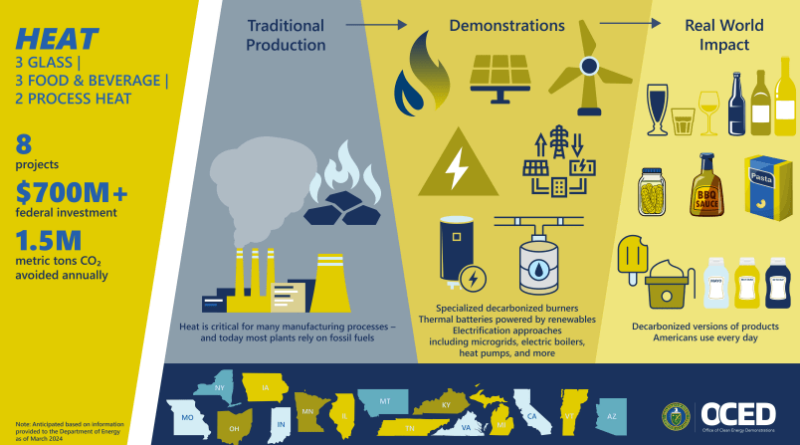More Hotshots Pick Hot Bricks For Industrial Energy Storage
Much attention has been turned to zeroing out greenhouse gas emissions in the the electric vehicle field, but that’s minor league stuff compared to the challenge of decarbonizing the heat and electricity that power industrial processes. New energy storage technology has been emerging as a big-league solution, and the US startup Rondo Energy is among the innovators offering it up.
Solving The Industrial Energy Storage Riddle
To be clear, new energy storage platforms won’t knock lithium-ion batteries out of the ring, but they will crack open new opportunities to clean up industrial processes that have resisted decarbonization through other means.
As of this writing, an old technology — pumped hydropower energy storage — still dominates the non-battery storage field, by a wide margin. However, pumped storage is limited to particular circumstances of elevation and water resources. Some innovative pumped hydro solutions are beginning to emerge, helping to expand the range of applications. Still, the ideal solution would be a scalable system that industrial facilities can install on site.
The California startup Rondo Energy is among the innovators focusing on solid state thermal energy systems. The thermal approach has already gotten a workout in concentrating solar systems, which gather solar energy from a field of specialized mirrors and focus it on a carrier and storage medium, such as molten salt or a specialized oil.
Concentrating solar systems are large, bulky affairs that are difficult to scale for on-site industrial use. That’s a job for thermal systems that deploy bricks, blocks, or other solid objects. The blocks can be heated by electricity, not direct solar energy, which means they can store wind energy or any other available resource.
€75 Million For Thermal Energy Storage Solutions
Rondo Energy stepped into the CleanTechnica radar last August, when the firm announced a $60 million funding round to bring a new thermal battery to market, called the “Rondo Heat Battery.” Rio Tinto, the Climate Innovation Fund of Microsoft, Aramco Ventures, SABIC, SCG, TITAN, Breakthrough Energy Ventures, Energy Impact Partners, and SDCL SEEIT were all on board as investors, along with the US engineer and venture capitalist John Doerr.
The Heat Battery deploys bricks infused with iron wire, which act as heating elements. The system has been compared to an electric toaster oven, but it’s not likely that your toaster oven can go as high as 1,500 degrees centigrade.
Transferring the heat is the tricky part. For that, Rondo leans on a stream of superheated air. Depending on the industrial process at hand, the hot air can be applied directly, or it can go to a steam generation station.
“This technology allows for decarbonization of industrial heat supply and can contribute to increased flexibility of the power system, therefore ensuring security of electricity supply, and for increasing the grid resiliency to intermittent power generation from renewable energy sources,” Rondo explains.
US Energy Storage Startup Hops The Pond
If you noticed the global reach of Rondo’s investors, that helps explain why the EU-Catalyst partnership has contributed to a newly announced €75 million funding pot for Rondo, aimed at expanding the firm’s European footprint. Breakthrough Energy also chipped in to the effort.
“Rondo will use the funding to expand its European presence and build projects delivering low-cost, continuous, high-pressure, zero-carbon steam and power as a service,” explains the European Investment Bank, which shepherded the funding round.
“This involves the construction of first-of-a-kind utility-scale long duration energy storage units with power-to-heat technology,” they add.
Although the Heat Battery is source-agnostic, EIB expects that the funded projects will deploy dedicated renewable resources, or they will draw off-peak electricity from the grid when more renewables are generally available.
EIB Vice-President Thomas Östros has indicated that investing in the Heat Battery is a significant step for itself, the EU-Catalyst, and the ability of EU industries to compete on a global scale.
“With today’s announcement, we are writing the next chapter of the EU-Catalyst partnership,” he said. “As the climate bank, we aim to finance many more net-zero technologies that will provide clean and affordable energy to power our industry and homes, while strengthening Europe’s competitiveness.”
Everybody Loves Thermal Energy Storage
Fossil energy stakeholders are among Rondo’s investors, so the funded projects will not completely push fossil resources out of the picture. The Heat Battery is already planned for a plastics manufacturing facility in Germany, for example.
That’s not particularly unusual. Fossil energy operations and related systems have leaned on renewable resources for decades, and the pace of interest has begun to pick up with the falling cost of wind and solar power.
So, it’s no surprise to find chemical producers among the industries targeted by EIB. The bank also lists foods and clean fuels among the areas of focus.
Here in the US, the Department of Energy is also targeting food production for thermal energy storage deployment, through its Office of Clean Energy Demonstrations.
Among the OCED’s $25 billion portfolio is a $75-million cost-share award to Diageo Americas Supply, aimed at installing Rondo Heat Batteries to replace gas-fired heat at two Diageo beverage facilities in Kentucky and Illinois, which produce readymade cocktails and Bulleit whiskey, along with other spirits.
“These facility upgrades would provide a highly replicable blueprint for how manufacturing facilities can integrate thermal batteries with intermittent renewable energy to achieve direct decarbonization while reliably and competitively delivering a consumer-facing product to market,” OCED explains.
As part of the project, Diageo is committed to sharing its air and water quality monitoring results with the public, under the anticipation of reducing air pollution in surrounding communities.
More Thermal Batteries For The EU
Turning back to the EU, in addition to the project in Germany, Rondo also notes a high pressure steam operation at the GreenLab campus in Denmark on its to-do list.
“Industry accounts for approximately 25% of energy-related carbon pollution globally, and 74% of industrial energy use is tied to heat,” explains GreenLab CEO Christopher Sorensen. “On a global level, powering industrial heat with renewables and heat batteries can cut CO2-emissions drastically.”
Another EU project in the pipeline involves “deep decarbonization” for food and beverage production, leveraging both onsite and offsite solar arrays. More details on that project are expected shortly.
Rondo is also collaborating with Breakthrough Energy Catalyst to develop a business model that eliminates the “green premium,” which refers to the higher cost of renewable resources. The company anticipates that the storage-as-a-service model will turn the tables on fossil energy, with the first round of EU-funded projects to make a real-world case for cutting costs.
“Each of these projects is an energy services project that delivers long-term low-cost clean energy for an industrial producer, reducing reliance on imported fossil fuel, cutting regulatory risk, and improving their position as manufacturing leaders in the 21st century,” Rondo emphasizes.
“These initial projects set the stage to accelerate Rondo’s delivery on its large pipeline of global projects which will reduce industrial reliance on gas and build sustainable, cost-effective energy solutions across the world,” Rondo adds.
Keep an eye on the Energy Resiliency Leadership Group, of which Rondo is a member, for new market-moving developments over the coming months and years.
Follow me @tinamcasey on Bluesky, Threads, Instagram, and LinkedIn.
Image: New thermal energy storage technology is being deployed to reduce greenhouse gas emissions from industrial facilities that have resisted decarbonization through other means (courtesy of US Department of Energy).
Have a tip for CleanTechnica? Want to advertise? Want to suggest a guest for our CleanTech Talk podcast? Contact us here.
Latest CleanTechnica.TV Videos

CleanTechnica uses affiliate links. See our policy here.

